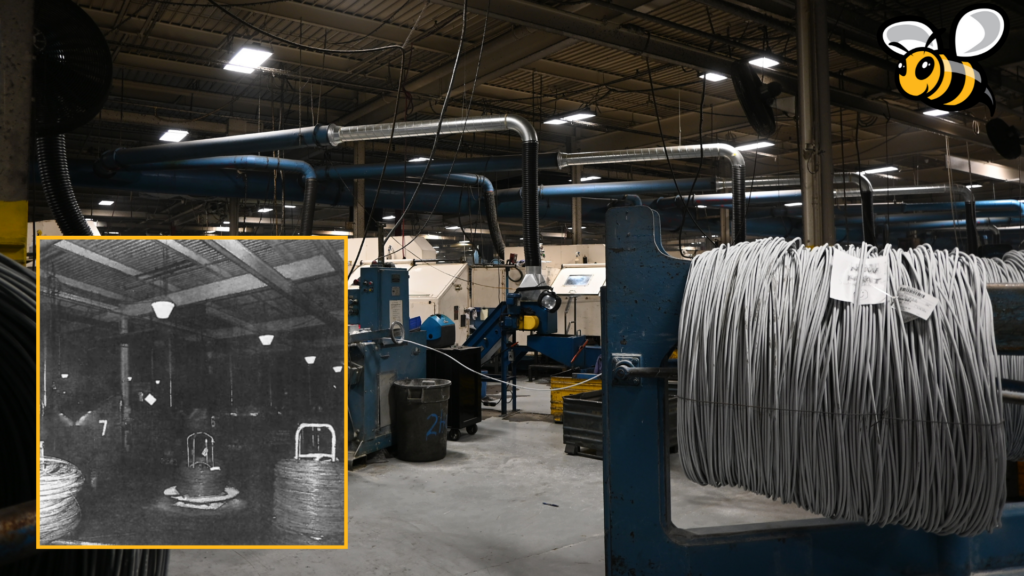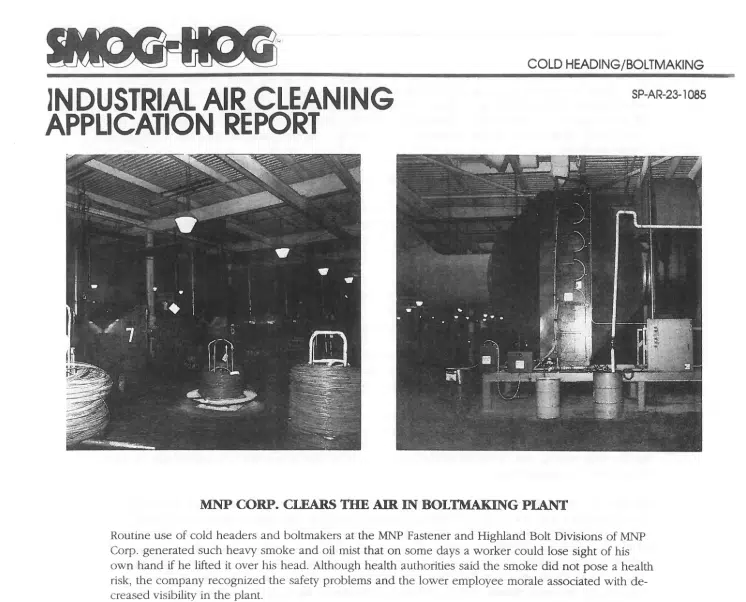MNP Corp. Clears the Air in Boltmaking Plant

Routine use of cold headers and boltmakers at the MNP Fastener and Highland Bolt Divisions of MNP Corp generated such heavy smoke and oil mist that on some days, a worker could lose sight of his hand if he lifted it over his head. Although health authorities said the smoke did not pose a health risk, the company recognized the safety problems and the lower employee morale associated with decreased visibility in the plant.
MNP’s Highland Bolt Division has the largest number of high-speed boltmakers in the United States, specializing in the cold heading of bolts in its Utica, Michigan, plant. The plant’s main product is hexbolts used by the automotive and distributor markets. The raw material used in manufacturing such bolts is coated with an oil lubricant. As the stock is processed through the various cold forming operations in high-speed boltmakers, considerable heat is generated, producing an extremely heavy smoke combined with an oil mist that spreads throughout the plant.
Although the smoke had been a continuing problem for MNP Corp, the company had not been able to find a good solution. In the summer, exhaust fans were used to draw the smoke outdoors, but this approach was unsatisfactory for year-round use because, in the winter, in many cases, employees turned on the exhaust fans just to obtain temporary relief from their visibility problems. MNP Corp recognized that the smoke was not only an irritation to employees, but also a source of expense in additional heating costs.
In 1982, MNP Corp committed itself to solving the smoke problem. Tom Klein, Plant Manager, began the process by consulting with several companies specializing in fans, air cleaners, and similar equipment. Because of the internal design of the plant, MNP Corp presented unusual challenges to the manufacturers of air cleaning equipment.
Thick smoke was being generated by 11 separate boltmakers in the plant. These machines could not be enclosed, so any set-up to eliminate smoke would require a custom-built duct system to capture the smoke produced by each machine. The special requirements for designing ductwork daunted several interested suppliers, but the sales representative for SMOG-HOG Industrial Air Cleaners prepared a proposal for a tailor-made system, working with another firm that specialized in designing and building unique ductwork.
The SMOG-HOG representative recommended the installation of 11 SMOG-HOG SH-40-PE-S-EF industrial air cleaner cart-mounted units, rated at 4300 CFM each, and a mobile ELECTRO-FOAMER cart-mounted cleaning system, manufactured by United Air Specialists, Inc., Cincinnati, Ohio. One SMOG-HOG was to be ducted to each smoke-generated machine. Unlike the other bidders, UAS guaranteed that the 11 SMOG-HOGs would solve the smoke problem that the machines generated. The proposal was accepted and 11 units were installed in 1984.

Once the SMOG-HOGs were installed, operating and eliminating the smoke generated by the 11 machines, Klein realized that some smoke was still entering the 120,000 sq. ft. plant area from other sources. Klein found that 18 cold headers in a nearby production line were still generating a noticeable amount of smoke. In fact, the plant manager determined that these machines produced approximately 30% of the smoke that has been observed in the plant before the SMOG-HOG installation. Having full confidence that in UAS, Klein put the company to work developing a plan to clean up this remaining 30% of the smoke. UAS used a different approach in this situation, designing a SMOG-HOG installation with one large central air cleaning unit ducted to the 18 individual cold headers.
The 11 original SMOG-HOG units are cleaned weekly using the mobile ELECTRO-FOAMER system designed to remove oily and wet particulate from the collecting components of the SMOG-HOG units. Because the ELECTRO-FOAMER is cart-mounted, it can be moved around to service all the units on a regular basis. Maintaining the SMOG-HOGs by using the ELECTRO-FOAMER cart system is easy enough to be done on a routine basis.
The cleaning system for the single central unit has the important advantage of being fully automated and maintenance-free. It is programmed to go through a complete self-cleaning cycle once a week, without any worker intervention. The maintenance of the SMOG-HOGs was a critical concern for Tom Klein, who knew that difficult or complex cleaning and maintenance requirements would mean that the equipment would eventually stop working as a result of inadequate regular care. He recognized that “The only way the equipment will be properly maintained is if it’s easy to do.” Easy self-cleaning was critical to the long-term success of MNP’s efforts to eliminate smoke in the plant. According to Klein, “There’s nothing to it.”
The SMOG-HOG installation has the expected benefits in the areas of increased productivity, improved working conditions and employee morale, as well as savings in heating costs in the winter. In addition, workers at MNP Corp found that they could drain 1-½ quarts of pure lubricant daily from each of the 11 original SMOG-HOGs and reuse it in the cold heading process.
Klein is extremely satisfied with every aspect of the industrial air cleaning systems. He says the SMOG-HOGs and associated ducts even look good. He is also impressed with the responsiveness of the sales and service people at UAS, who, he says, “Went out of their way to do it right and do it quickly.”
Note: The self-wash system is no longer in use; Bee Clean now maintains the air cleaners.
Source: Parker case study, 1982